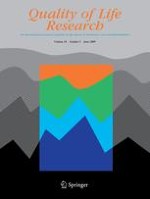01-06-2009
Psychometric evaluation of the WHOQOL-BREF in community-dwelling older people in Taiwan using Rasch analysis
Gepubliceerd in: Quality of Life Research | Uitgave 5/2009
Log in om toegang te krijgenAbstract
Objective
To examine the psychometric characteristics of the brief version of the World Health Organization Quality of Life (WHOQOL-BREF) questionnaire in rural-community-dwelling older people in Taiwan using Rasch analysis.
Methods
This is a cross-sectional study. A total of 1200 subjects aged ≥65 years were recruited to complete the 26-item WHOQOL-BREF. Scale dimensionality, item difficulty, scale reliability and separation, item targeting, item-person map, and differential item functioning (DIF) were examined.
Results
The four WHOQOL-BREF scales (physical capacity, psychological well-being, social relationships, and environment) were found to be unidimensional and reliable. The item–person map for each domain indicated that the spread of the item thresholds sufficiently covered the latent trait continuum being measured. However, gaps in content coverage were identified in the social domain. Analyses of the DIF revealed that one psychological item (body image) exhibited DIF across the two age groups (old–old vs. young–old) and that two social items (sexual activity and friends’ support) displayed DIF across genders and the two age groups.
Conclusions
Rasch analysis is a comprehensive method of psychometric evaluation of the WHOQOL-BREF and identifies areas for improvements. Three items displaying age-related DIF (body image, sexual activity, and friends’ support) may potentially cause biased health-related QOL assessments, and their impacts on scores should be carefully examined.
